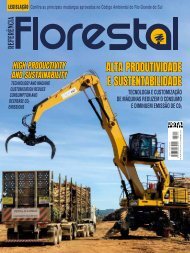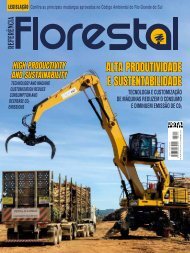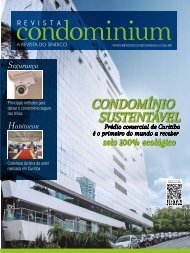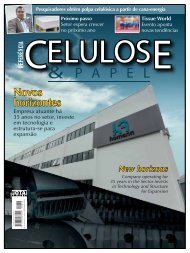Create successful ePaper yourself
Turn your PDF publications into a flip-book with our unique Google optimized e-Paper software.
Conservar a biodiversidade sem comprometer<br />
o desenvolvimento econômico e<br />
social é um dos maiores desafios deste<br />
século. Neste contexto, o mercado e a indústria<br />
estão cada vez mais atentos para a<br />
necessidade de cumprir metas de desenvolvimento. E<br />
isso está diretamente ligado a uma gestão mais eficaz<br />
e responsável dos recursos.<br />
A indústria, que depende de recursos naturais,<br />
desde água potável até proteção contra desastres<br />
naturais, reconhece que precisa olhar para o cenário<br />
geral e buscar compreender como suas atividades<br />
estão ligadas à biodiversidade e aos serviços ecossistêmicos<br />
de sua bacia hidrográfica, por exemplo.<br />
“Isso é necessário para sobrevivência e prosperidade,<br />
e o número de empresas que vem se atentando e<br />
atuando em prol de deixar o ambiente melhor do que<br />
encontrou vem aumentando”, explica a Dra. Tatiana<br />
Furley, Immediate Past President da Setac (Sociedade<br />
de Toxicologia e Química Ambiental da América Latina)<br />
e fundadora e membro do Conselho Deliberativo<br />
e de Inovação da Aplysia, empresa especializada em<br />
soluções ambientais com foco em recursos hídricos.<br />
O SETOR DE CELULOSE E O IMPACTO<br />
POSITIVO<br />
Temas que concernem ao setor foram discutidos<br />
com profundidade durante o II Jantar da Aplysia, no<br />
dia 22 de outubro de <strong>2019</strong>, em São Paulo. O encontro<br />
contou com representantes das principais indústrias<br />
de celulose e papel do país.<br />
“O evento visou estimular a prática do conceito<br />
NPI (Net Positive Impact ou Impacto Líquido Positivo),<br />
exemplificando como o setor de celulose pode ir<br />
além. “Uma maneira por exemplo é Renaturalizando<br />
os rios, e trazendo de volta as suas funções ambientais<br />
como: controle dos sólidos suspensos na água,<br />
aumento da biodiversidade, controle de enchentes e<br />
seca, resultado possível de ser alcançado por meio da<br />
técnica pioneira desenvolvida pela Aplysia”, explicou<br />
Tatiana Furley.<br />
Atingir as metas NPI significa que os impactos<br />
negativos gerais de um projeto na biodiversidade são<br />
superados pelos ganhos alcançados através de iniciativas<br />
de conservação e recuperação ambiental na<br />
mesma região, mesmo que seja inevitável que outras<br />
perdas ainda ocorram no local do desenvolvimento.<br />
A contabilização de tudo isso é de extremo valor, e<br />
vale comentar que ter o Baseline bem estabelecido<br />
C<br />
onserving biodiversity without compromising<br />
economic and social development is one of<br />
the biggest challenges of this century. In this<br />
context, the market and industry are increasingly<br />
attentive to the need to meet development<br />
goals. And this is directly linked to more active and<br />
responsible resource management.<br />
Industry, which relies on natural resources, from<br />
drinking water to protection against natural disasters,<br />
recognizes that it needs to look at the general scenario<br />
and seek to understand how its activities are linked<br />
to biodiversity and ecosystem services focused on<br />
watershed resources, for example.<br />
“This is necessary for survival and prosperity, and<br />
the number of companies that have been paying<br />
attention to this and acting in favor of making the<br />
environment better than they found it has been<br />
increasing,” explains Dr. Tatiana Furley, Immediate Past<br />
President of the Latin American Society of Toxicology<br />
and Environmental Chemistry (Setac) and founding<br />
member of the Deliberative Council and member of<br />
Council for Innovation of Aplysia, a company specializing<br />
in environmental solutions focused on water<br />
resources.<br />
THE PULP SECTOR AND ITS POSITIVE IMPACT<br />
During the IInd Aplysia Dinner held in São Paulo<br />
on October 22, <strong>2019</strong>, topics concerning the Sector<br />
were discussed in depth. The meeting was attended<br />
by representatives of the leading pulp and paper<br />
companies in the Country. “The event aimed to<br />
stimulate the practice of the “Net Positive Impact”<br />
concept (NPI), exemplifying how the Pulp Sector can<br />
go further. “One way, for example, is to “renaturalize”<br />
rivers, and returning them to their environmental<br />
functions such as control of suspended solids in water,<br />
increased biodiversity, and flood and drought control,<br />
possible through the results being achieved through<br />
the pioneering technique developed by Aplysia,”<br />
explains Dr. Furley.<br />
Achieving NPI targets means that the overall negative<br />
impacts of a project on biodiversity are overcome<br />
by the gains made through environmental conservation<br />
and recovery initiatives in the same region, even<br />
if it is inevitable that further losses occur in location<br />
development. Accounting for all this is of extreme<br />
value, and it is worth commenting that having a<br />
well-established baseline is critical to measurement.<br />
Moreover, this same baseline could serve as a “zero<br />
47
















